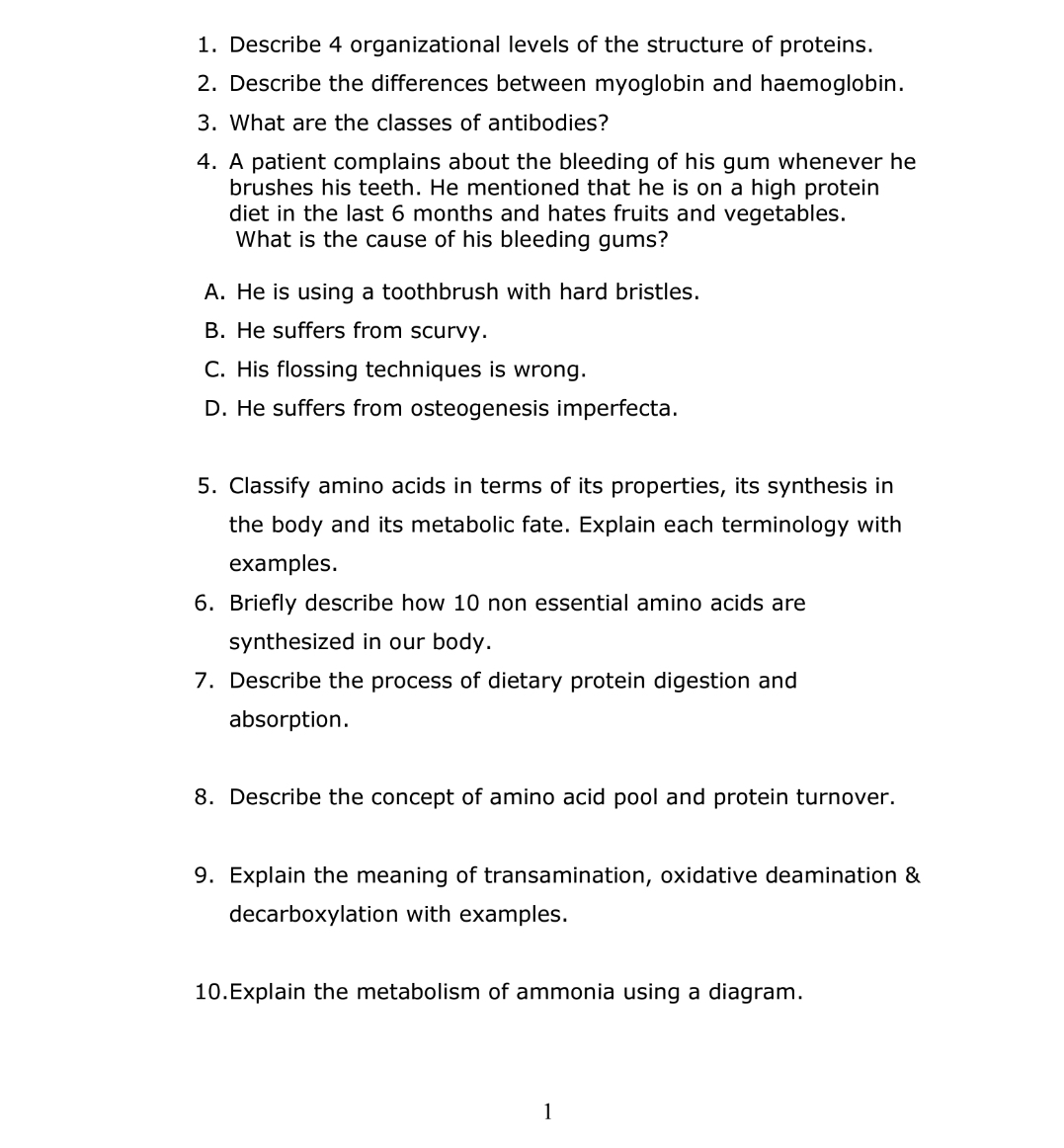Describe 4 organizational levels of the structure of proteins. Describe the differences between myoglobin and haemoglobin. What are the classes of antibodies? A patient complains a... Describe 4 organizational levels of the structure of proteins. Describe the differences between myoglobin and haemoglobin. What are the classes of antibodies? A patient complains about the bleeding of his gum whenever he brushes his teeth. He mentioned that he is on a high protein diet in the last 6 months and hates fruits and vegetables. What is the cause of his bleeding gums? Classify amino acids in terms of its properties, its synthesis in the body and its metabolic fate. Explain each terminology with examples. Briefly describe how 10 non essential amino acids are synthesized in our body. Describe the process of dietary protein digestion and absorption. Describe the concept of amino acid pool and protein turnover. Explain the meaning of transamination, oxidative deamination & decarboxylation with examples. Explain the metabolism of ammonia using a diagram.

Understand the Problem
The image contains a set of biology questions related to proteins, amino acids, and metabolism. The questions require knowledge of protein structure, antibody classes, amino acid classification, protein digestion, and metabolic processes.
Answer
Detailed answers to the questions regarding protein structure, function, amino acids, and metabolism are provided above.
-
The four levels of protein structure are:
- Primary: The amino acid sequence.
- Secondary: Local folding patterns like alpha helices and beta sheets.
- Tertiary: The overall 3D structure of a single protein molecule.
- Quaternary: The arrangement of multiple protein subunits in a multi-subunit complex.
-
Myoglobin stores oxygen in muscle cells and has a tertiary structure. Hemoglobin transports oxygen in red blood cells and has a quaternary structure, composed of four subunits.
-
The classes of antibodies (immunoglobulins) are: IgA, IgD, IgE, IgG, and IgM.
-
B. He suffers from scurvy. Scurvy is caused by vitamin C deficiency, which leads to bleeding gums.
-
Amino acids can be classified based on:
- Properties: Nonpolar, polar (neutral), acidic, and basic.
- Synthesis: Essential (must be obtained from the diet) and non-essential (can be synthesized in the body).
- Metabolic fate: Glucogenic (can be converted to glucose), ketogenic (can be converted to ketone bodies), or both.
-
Non-essential amino acids are synthesized through various metabolic pathways. For example, alanine is synthesized from pyruvate by transamination.
-
Dietary protein digestion begins in the stomach with pepsin. Further digestion occurs in the small intestine by pancreatic proteases. Amino acids and small peptides are absorbed into the bloodstream.
-
The amino acid pool refers to the free amino acids available in the body for protein synthesis and other metabolic processes. Protein turnover is the continuous synthesis and degradation of proteins.
-
- Transamination: Transfer of an amino group from one amino acid to a keto acid.
- Oxidative deamination: Removal of an amino group from an amino acid, producing ammonia.
- Decarboxylation: Removal of a carboxyl group from an amino acid, forming an amine.
-
Ammonia metabolism involves the urea cycle, which converts toxic ammonia into urea for excretion.
Answer for screen readers
-
The four levels of protein structure are:
- Primary: The amino acid sequence.
- Secondary: Local folding patterns like alpha helices and beta sheets.
- Tertiary: The overall 3D structure of a single protein molecule.
- Quaternary: The arrangement of multiple protein subunits in a multi-subunit complex.
-
Myoglobin stores oxygen in muscle cells and has a tertiary structure. Hemoglobin transports oxygen in red blood cells and has a quaternary structure, composed of four subunits.
-
The classes of antibodies (immunoglobulins) are: IgA, IgD, IgE, IgG, and IgM.
-
B. He suffers from scurvy. Scurvy is caused by vitamin C deficiency, which leads to bleeding gums.
-
Amino acids can be classified based on:
- Properties: Nonpolar, polar (neutral), acidic, and basic.
- Synthesis: Essential (must be obtained from the diet) and non-essential (can be synthesized in the body).
- Metabolic fate: Glucogenic (can be converted to glucose), ketogenic (can be converted to ketone bodies), or both.
-
Non-essential amino acids are synthesized through various metabolic pathways. For example, alanine is synthesized from pyruvate by transamination.
-
Dietary protein digestion begins in the stomach with pepsin. Further digestion occurs in the small intestine by pancreatic proteases. Amino acids and small peptides are absorbed into the bloodstream.
-
The amino acid pool refers to the free amino acids available in the body for protein synthesis and other metabolic processes. Protein turnover is the continuous synthesis and degradation of proteins.
-
- Transamination: Transfer of an amino group from one amino acid to a keto acid.
- Oxidative deamination: Removal of an amino group from an amino acid, producing ammonia.
- Decarboxylation: Removal of a carboxyl group from an amino acid, forming an amine.
-
Ammonia metabolism involves the urea cycle, which converts toxic ammonia into urea for excretion.
More Information
Comprehensive answers based on general knowledge of biochemistry and related fields.
Tips
When describing metabolic processes, diagrams greatly aid understanding and communication.
Sources
- Myoglobin vs. Hemoglobin: What's the Difference? - BuzzRx - buzzrx.com
- Difference between Hemoglobin and Myoglobin - BYJU'S - byjus.com
- Protein structure: Primary, secondary, tertiary & quatrenary (article) - khanacademy.org
AI-generated content may contain errors. Please verify critical information